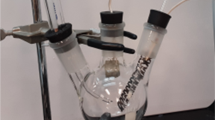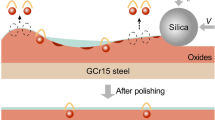Abstract
Wear rates of grinding media can be misrepresented by marked ball wear tests (MBWT). Galvanic interactions between dissimilar grinding media can be affected by the chromium content in the media and the presence of oxygen in the environment. Corrosion, one component of wear, can be affected by many variables. Corrosion rates and corrosion potentials for modern high chromium white iron (HCWI) and high carbon steel (HCS) grinding media samples were obtained through electrochemical testing. In this study, the impact of chromium content in the grinding media and the dissolved oxygen in a simulated mill water solution on corrosion rates and potentials was examined. Increasing chromium content in HCWI above 15 weight percent increases the corrosion potential and decreases corrosion rate. Removing most of the oxygen from the solution lowers both the corrosion potential and corrosion rate of the materials tested. The electrochemical results were examined to model possible galvanic coupling effects on corrosion rates. Galvanic coupling between HCS and HCWI could cause differences in corrosion rates for almost all scenarios modeled. Based on the galvanic coupling analysis, MBWT results could be impacted by mixing HCWI and HCS in a ball mill charge. This impact is predicted to be more significant when dissolved oxygen is present in the mill water and as the chromium content of HCWI is above 15 weight percent.














Similar content being viewed by others
References
Iwasaki I, Pozzo RL, Natarajan KA, Adam K, Orlich JN (1988) Nature of corrosive and abrasive wear in ball mill grinding. Int J Mineral Process 22:13 4-325 360
Isaacson AE (1989) Effect of sulfide minerals on ferrous alloy grinding media corrosion U.S. Dept. of the Interior, Bureau of Mines, Report of Investigations (United States Bureau of Mines); 9244
Aldrich C (2013) Consumption of steel grinding media in mills – a review. Miner Eng 49:77–91
Le Bozec N, Compère C, L’Her M, Laouenan A, Costa D, Marcus P (2001) Influence of stainless steel surface treatment on the oxygen reduction reaction in seawater. Corros Sci 43(4):765–786
Vermeulen LA and Howat DD (1983) Theories of ball wear and the results of a marked-ball test in ball milling. J South Afr Inst Min Metall 83:8
Zumelzu E, Goyos-Pérez L, Cabezas C, Opitz O, Parada A (2002) Wear and corrosion behaviour of high-chromium (14–30% CR) cast iron alloys. J Mater Process Technol 128(1–3):250–255
Baotong Lu, Luo J, Chiovelli S (2006) Corrosion and wear resistance of chrome white irons—a correlation to their composition and microstructure. Metall Mater Trans A 37(10):3029–3038
Tang XH, Chung R, Li DY, Hinckley B, Dolman K (2009) Variations in microstructure of high chromium cast irons and resultant changes in resistance to wear, corrosion and corrosive wear. Wear 267:1 4-116 121
Kerber Susan J (2000) Tverberg, John. Stainless Steel Adv Mater Process 158:5–33
Gundewar CS, Natarajan KA, Nayak UB, Satyanarayana K (1990) Studies on ball wear in the grinding of Kudremukh hematite-magnetite ore. Miner Eng 3(1–2):207–220
Wang J, Su H, Ajmand F, Zhang L, Chen K (2019) Effects of corrosion potential, dissolved oxygen, and chloride on the stress corrosion cracking susceptibility of a 316ng stainless steel weld joint. Corrosion 75(8):946–959
Tait WS (1979) Effect of physical parameters on the pitting corrosion of mild steel in low total dissolved solids, oxygen bearing waters: a nonpassivating metal/environment system. Corrosion 35(7):296–300
Tolley William K, Ivan Nichols L and Huiatt JL (1984) Corrosion rates of grinding media in mill water. USBM Rep Investig 8882
Vathsala K.A. Natarajan (1989) Some electrochemical aspects of grinding media corrosion and sphalerite flotation. Int J Mineral Proc 26(3–4):193–203
Huang GZ, Grano S (2006) Galvanic interaction between grinding media and arsenopyrite and its effect on flotation: part II effect of grinding on flotation. Int J Mineral Process 78(3):198–213
Huang GZ, Grano S (2008) Electrochemical interaction of bornite with grinding media and its effect on flotation. Mineral Process Ext Metall 117(4):214–220
Meulendyke MJ, Moroz PJ, Smith DM (1987) Practical aspects of corrosion in the wear of grinding media. Mining Metall Explor 4:72–77
Meulendyke MJ, Purdue JD (1989) Wear of grinding media in the mineral processing industry: an overview - mining, metallurgy & exploration. Springer International Publishing, SpringerLink
ASTM Standard E2594–20 (2020) Standard test method for analysis of nickel alloys by inductively coupled plasma atomic emission spectrometry (performance-based). ASTM Int. https://doi.org/10.1520/E2594-20
ASTM Standard E1019-18 (2018) “Standard test methods for determination of carbon, sulfur, nitrogen, and oxygen in steel, iron, nickel, and cobalt alloys by various combustion and inert gas fusion techniques,” ASTM Int. https://doi.org/10.1520/E1019-18
ASTM Standard E3–11 (2017) Standard guide for preparation of metallographic specimens ASTM Int. https://doi.org/10.1520/E0003-11R17
Andrade C, Alonso C (2004) Test methods for on-site corrosion rate measurement of steel reinforcement in concrete by means of the polarization resistance method. Mater Struct. SpringerLink, Kluwer Academic Publishers
Krauss, George (1990) Chapter 12: Stainless steels., Chapter 14: Cast irons. Steels: heat treatment and processing principles, ASM International, Materials Park, OH
Macdonald DD (1999) Passivity–the key to our metals-based civilization. Pure Appl Chem 71(6):951–978
Acknowledgements
We acknowledge Molycop.
Funding
This research was funded by Molycop.
Author information
Authors and Affiliations
Corresponding author
Ethics declarations
Competing Interests
The authors declare no competing interests.
Additional information
Publisher's Note
Springer Nature remains neutral with regard to jurisdictional claims in published maps and institutional affiliations.
Rights and permissions
Springer Nature or its licensor (e.g. a society or other partner) holds exclusive rights to this article under a publishing agreement with the author(s) or other rightsholder(s); author self-archiving of the accepted manuscript version of this article is solely governed by the terms of such publishing agreement and applicable law.
About this article
Cite this article
Fletcher, J.B., Moats, M.S. Understanding Charge Effects on Marked Ball Wear Rates: a Corrosion Study — Part 2. The Impact of Chromium Content in Media and Dissolved Oxygen. Mining, Metallurgy & Exploration 40, 49–56 (2023). https://doi.org/10.1007/s42461-022-00711-z
Received:
Accepted:
Published:
Issue Date:
DOI: https://doi.org/10.1007/s42461-022-00711-z




